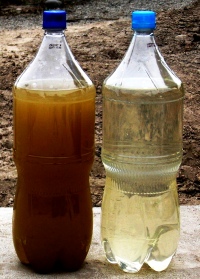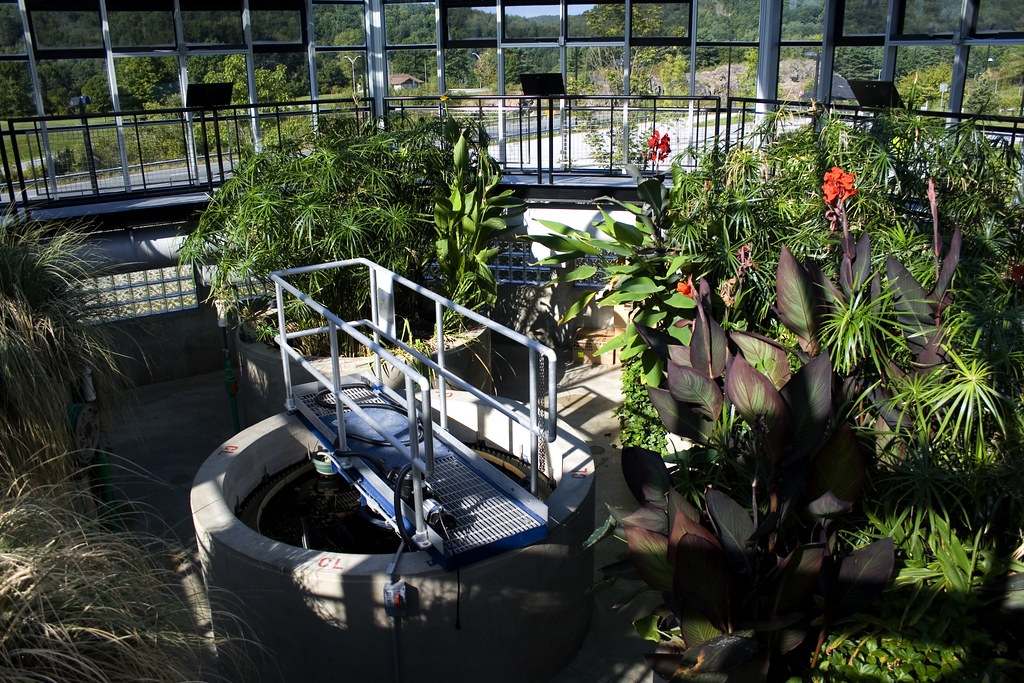6.3 Water treatment systems

Water treatment technologies are designed to eliminate harmful effects of pollutants and natural substances to human health and environment. Within the blended water cycle (considered on page 6.1), these technologies are often placed at the transitions between the environment and human sphere to adapt the water quality.
For example, when water passes from the environmental source to the human consumption system, there is a possible risk to human health from some natural bacteria, chemical elements. Hence, natural water (from either surface or underground reservoir) needs to be purified to a certain standard. On the other end of the system, the water containing waste or substances resulting from the domestic, agricultural, or industrial activity must be cleaned before returning to the environmental pathways. If this is not done, harmful effects of concentrated pollutants can cause significant disturbance to the natural water ecology and escalate damage to both ecosystem and society in the long run. Some common effects of wastewater pollution include eutrophication (biological nutrient pollution; for example, releasing access of nitrogen and phosphorus —"overfeeding ecosystem"); oxygen depletion (due to oxidation of organic compounds); odor and aesthetic damage; proliferation of harmful bacteria, viruses, fungi in drinking water supply.
Centralized water treatment
Centralized water treatment approach implies treating large amounts of water at large rates in a "central" location and distributing that water via networks of pipelines, channels, and intermediate reservoirs. Centralized water treatment is largely implemented and maintained in major urban areas and in most parts of the developed world. Probably most of us primarily use the centralized treatment in our lives (maybe except some travel circumstances).
A couple of videos below describe large-scale water treatment systems that are designed to remove undesired contaminants from water.
This first video shows an example of how water is treated during its transfer from the environmental source to the drinking water supply:
Video: Water Treatment Plant Tour (5:26)
This second video illustrates the treatment of the wastewater generated by human activity before it is returned to the environment:
Video: Barry's Wastewater Treatment Tour (5:26)
As we can see from these videos, the design of a large-capacity water treatment plant is very complex and involves not one but many steps, each of those utilizing multiple technologies. It is not our goal to learn all of them in detail in one lesson. However, should you have a specific interest in this topic, the US EPA Wastewater Technology Fact Sheets(link is external) web page can serve as a great resource for obtaining more technical information about them.
Depending on the degree of cleaning and purification, treated water can be reused for:
- irrigation of agricultural crops or landscape irrigation (e.g., schoolyards, golf courses, residential gardens);
- groundwater recharge;
- recreational use (e.g., lakes and ponds, fisheries, snowmaking, marsh enhancement);
- non-potable urban use (e.g., fire protection, air conditioning, toilet flushing);
- potable use;
- industrial use (e.g., cooling, process water).
The main concern in water reuse is to meet the water quality requirements for its intended use. Quality requirements are determined by federal, state, and regional regulatory authorities and may vary. The general guidelines by EPA with regards to the effluent from the wastewater treatment facilities are given in Table 6.2 below:
| Measures | Effluent Limitation | ||
|---|---|---|---|
| Daily maximum | Weekly average | Monthly average | |
| 5-day Biochemical Oxygen Demand (BOD5) | 60 mg/L | 45 mg/L | 30 mg/L |
| 5-day Carbonaceous Biochemical Oxygen Demand (CBOD5) | 50 mg/L | 40 mg/L | 25 mg/L |
| Total Suspended Solids (TSS) | 60 mg/L | 45 mg/L | 30 mg/L |
| pH (instantaneous) | 6.0-9.0 | --- | --- |
Here is an explanation of measures in this table if you are not familiar with the terms:
- BOD5 is the amount of oxygen needed to oxidize organic matter in a water sample. The difference in oxygen content is usually measured over the time span of 5 days (that is the reason for subscript 5). For reference, water from a very clear source may have a BOD of less than 2 mg/L; sewage water may give readings above 100 mg/L; food processing wastes may have BOD of thousands.
- CBOD5 is the amount of oxygen needed to oxidize carbonaceous organic matter (excluding nitrogen compounds)
- TSS is the amount of particulate matter (insoluble) present in a water sample, which is usually determined by filtering the solution and weighing the residue remaining on the filter.
- pH is the measure of acidity of solution in chemistry (defined as pH = -log[H+]). Acidic solutions, such as acid rain, may have pH around 1-2, relatively neutral solutions range within 5-9 (distilled water pH=7), and alkaline solutions have pH 10-14.
These limits determined by EPA are included in the government regulations, published in the Rules of Department of Natural Resources [CSR, 2014](link is external). This document also contains extensive data on limitations imposed on the contents of the toxic element in water before it is reused or discharged in a certain way to the environment. Check Table A for the maximum tolerated concentrations of metals (p.24) and organics (p. 26). The toxicity requirements are especially relevant to industrial water use.
Chemical tests to determine the above metrics are used as controls at any wastewater treatment plant. Various technologies are developed to improve the treatment efficiency and to produce a cleaner effluent suitable for further use.
Engineered ecological systems for water treatment
Traditional water treatment plants accomplish an important function. However, these facilities themselves produce significant environmental impact by consuming energy, producing emissions, by-products, and waste to be disposed of. Later in this lesson, an example is given for a life cycle assessment study which analyzes the way to make these systems more benign.
One of the trends in improving the environmental profile of wastewater treatment facilities is the design of ecological systems that mimic natural processes of neutralizing the pollution.

Here are a couple of examples of the development of such systems:
- Living Machine and Biomatrix systems(link is external) (see photo above):
- Eco-Machines systems(link is external) - ecological fluidized bed, or a small constructed wetland
These examples show that ecological treatment systems typically work at the small scale being capable to treat liquid waste from a community of 300-1000 people. This makes them attractive for decentralized treatment for secluded autonomous areas.
Decentralized systems for water treatment
Decentralized systems of water purification often become technologies of choice in developing countries because they do not require huge infrastructure or can be set up quicker when infrastructure is destroyed. Small-scale technologies provide quick response to urgent needs. There are multiple ways to approach the issue. Here is one of them: watch this 10 min video to see an example how small-scale technology can help solve large-scale problems.
Video: How to make filthy water drinkable (9:13)
Click on the link below to read about some small innovations that make big difference when applied at the right place at the right time:
6 Water-purifying Devices for Clean Drinking Water in the Developing World(link is external)
Reading Assignment:
Next, let us get a little bit deeper into the issue. I ask you to read the following paper which analyzes a case study of a decentralized wastewater treatment system in India. It covers enough technical details to understand how the technology works and provides a useful discussion of environmental, economic, and social aspects:
Dhinadhayalan, M., Nema, A., Decentralised wastewater management - New concepts and innovative technological feasibility for developing countries, Sustain. Environ. Res., 22(1), 39-44 (2012). (The full article is accessible via Library e-Reserves in Canvas)
While reading, focus on understanding the pros and cons of the decentralized approach (compared to central distribution system). In your own notes, list three key advantages of decentralized technologies that justify their development and implementation. Also, list three disadvantages that may limit their use in different parts of the world. Can you imagine to use only de-centralized water treatment in your current location? What kind of social impacts might it create?
Check Your Understanding
The BOD is a measure of which type of pollutant in the water?
Click for answer.
Check Your Understanding
Which stages in wastewater treatment are designed to decrease BOD of the effluent?
Click for answer.
